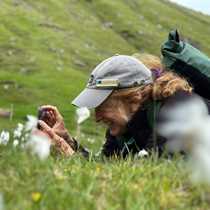The seasonal winds moving from the west to the east are funneled through the Columbia River Gorge and increase in velocity as they travel through this slot which slices the Cascade mountain range. The resulting increase in velocity is known as the Bernoulli Principle.
The Corps of Discovery wrote in their journals of an annoyance with spirited winds. Blowing winds picked up tiny particles of sand from the riverbanks and sandbars and drove airborne bits with force into the faces of the men. Lewis treated the resulting eye inflammations with "a solution of white vitriol and the sugar of lead in the proportion of 2 grs. of the former and one of the latter to each ounce of water."
As we travel in the wake of Lewis and Clark, we see the never-ending work of this force we call "the wind." Unlike the Corps of Discovery, we are never far from the shelter and comforts of our ship the Sea Bird.




